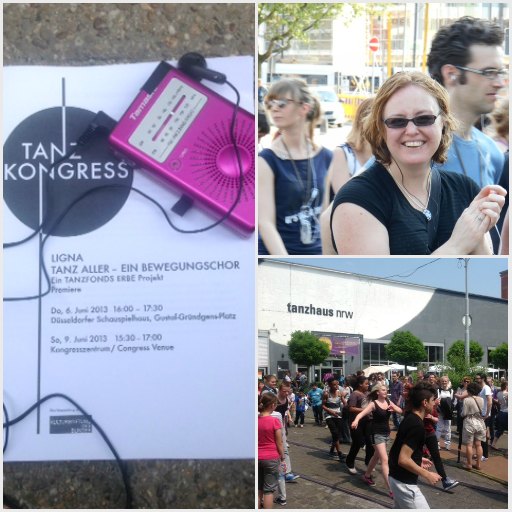What would an international dance conference be if it did not include an array of performances? Even though Tanzkongress itself was only three days, there were a significant range of performance, workshop and class opportunities.
The opening celebrations included the staging of a movement choir entitled Tanz Aller (everyone dancing). Audience members became the performers, directed through individual radio sets with the staging led by the artists' collective Ligna. Movement choirs were popular in 1920s Germany and used at rallies of the working class. The experience was a rich one, a great opportunity to bond with strangers from around the world as we formed patterns and movements, while also hearing the history of the movement choirs.
 Left: Radio sets were used to direct audience performers in the Tanz Aller movement choir. Right: Audience members performing in the Tanz Aller movement choir (photo Julie Dyson). Below right: Songlines Flash Mob
Left: Radio sets were used to direct audience performers in the Tanz Aller movement choir. Right: Audience members performing in the Tanz Aller movement choir (photo Julie Dyson). Below right: Songlines Flash MobThe main stage opening was a performance of La Creation du monde 1923 – 2012. This performance included a re-staging of the original la creation du monde; a so-called 'ballet negre' originally presented in 1923, book-ended by modern interpretations and questions on the themes presented in the ballet. Colonialism and the appropriations of African cultures were passionately explored by Congolese choreographer Faustin Linyekula and CCN-Ballet de Lorraine.
Other highlights on the program included a 20th Anniversary presentation by Candoco Dance Company. From London UK, Candoco was formed to provide an artistic vehicle for performers with and without disability. They have gathered a strong international reputation including a starring role in the ceremonies of the London Olympics. Chunky Move artistic director Anouk van Dijk teamed up with longer term collaborator Falk Richter for Rausch (intoxication). Seven dancers and five actors explored themes of freedom and connection in spell-binding mix of high-powered theatre and dance.
Of course there were also less formal performances. Dutch choreographer Erik Kaiel has been working with students from St Benedikt school in Duesseldorf, resulting in some flash mob performances in amongst the Congress participants.
Tanzkongress encouraged participation in the creation of new works, as well as the re-staging of the old, through its dance and workshop program. It was a valuable opportunity to see a range of performances from outside Australia.

